
Director: Mark Robson
By Roderick Heath
Not the most popular or famous of Val Lewton’s epochal series of low-budget horror films made for RKO Studios, The Seventh Victim is the deepest, the most original, perhaps the darkest, a film that tends to weave a powerful spell on those who tune into its peculiar wavelength. The fourth film in Lewton’s horror cycle, it was the directorial debut of Mark Robson, who, like Robert Wise, had worked as an editor at RKO. He was promoted after Lewton’s first director collaborator Jacques Tourneur graduated to bigger-budget productions, and who would go on to a long career with many strong films as well as some shamefully shoddy late career labours that bespoke cruel truths about the decline of the studio system and the talents it fostered.

Tourneur’s films with Lewton had clearly reflected both men’s status as immigrants, fascinated and alienated by the American landscape. Robson and Wise were more parochially alert, and facilitated a shift in focus in Lewton’s series to foreign and historical settings, where a similar sense of unfamiliarity could be sustained. The Seventh Victim looked back to the initial success of Lewton’s series, Cat People (1942), and to silent melodramas that had blended aspects of realism with fable-like storytelling precepts, like Victor Sjöstrom’s The Phantom Carriage (1920) and D.W. Griffith’s The Sorrows of Satan (1922), whilst also looking forward to many films, and indeed genres that didn’t yet exist. Jacques Rivette would strive to recapture its atmosphere with several films, particularly Duelle (1976). Alfred Hitchcock may have remembered it in the most famous scene of Psycho (1960). Roman Polanski would engage its ideas for Rosemary’s Baby (1968). Dario Argento channelled it for Inferno (1980). Stanley Kubrick would partly remake it as Eyes Wide Shut (1999). Hints of its influence are detectable in urban horror stories of Abel Ferrara, Martin Scorsese, and Brian De Palma.
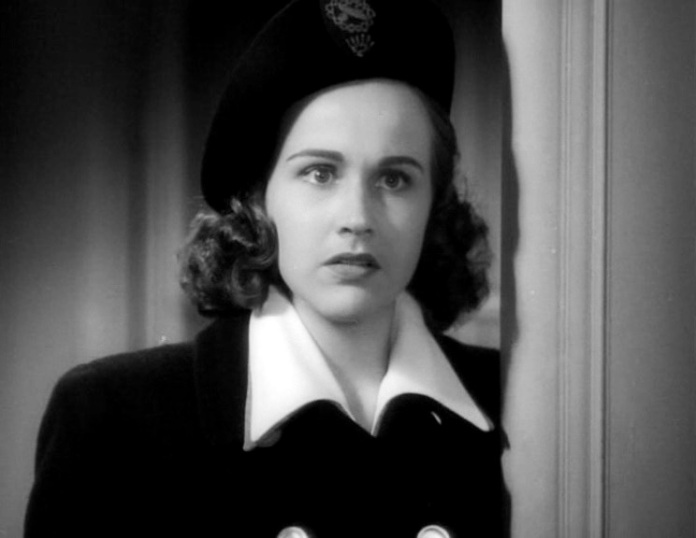
One reason for this slow yet indelible effect of The Seventh Victim was that it followed Cat People in proving a horror film could be set in a completely contemporary urban landscape, transformed into a world of dreamlike vignettes and private netherworlds, and unlike its precursor was able to do so without any hint of the supernatural, presenting a situation where human folly creates horror. Robson’s directing wasn’t as smoothly fluid and sophisticated as Tourneur’s had been, but to a certain extent his neophyte coolness helps exacerbate the sequestered mood. Like all of Lewton’s productions, the title came down from RKO honchos. But the erstwhile Ukrainian aesthete, who had immigrated to the US in the company of his aunt, the silent tragedienne Alla Nazimova, took an active interest in every level of his creations, as Lewton excelled his former employer David Selznick in fulfilling the ideal of producer as auteur. Lewton’s approach had a twofold strangeness stemming from linked urges, as he tried to set his dramas in a demonstrably real world, but also psychologised his narratives, and pared them back to simple, almost fairy tale-like precepts, an approach which Lewton would take to an apogee with the next film, Curse of the Cat People (1944), which bypasses horror altogether in spite of the title, and becomes instead a gothic-edged children’s film. Lewton’s fondness for deliberate naïveté is also apparent in The Seventh Victim, which tells the story of young Mary Gibson (Kim Hunter, in her first role) and her coming of age whilst on a Snow White-like adventure in the concrete forests of Manhattan. The film kicks off with a quote from John Donne, a quote so suitable it serves almost as the mission statement of the horror genre: “I runne to death, and death meets me as fast, and all my pleasures are like yesterday.”
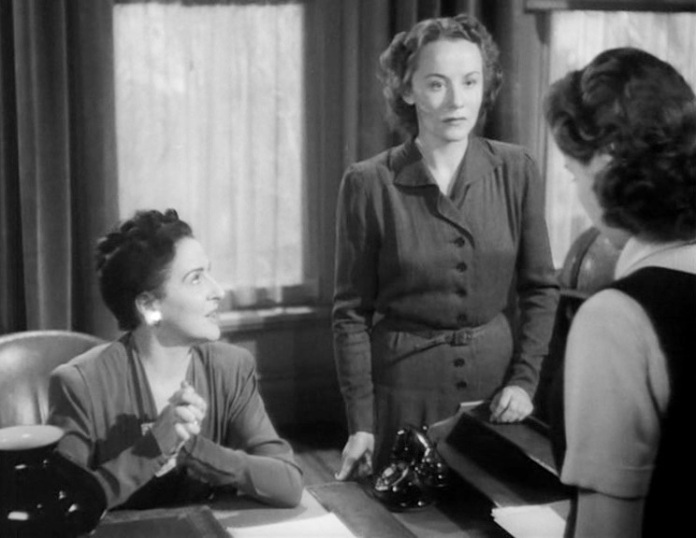
Like many fairy tales, this one starts with an exile from home, albeit a place that’s not really a home. The two Gibson sisters, Mary and older sibling Jacqueline (Jean Brooks) are orphans. Jacqueline has earned a living whilst Mary has grown in a girl’s boarding school. Called before the principal Mrs. Lowood (Ottola Nesmith) and her aide Miss Gilchrist (Eve March), she is told that her sister has been out of touch, and her tuition hasn’t been paid for six months. Mary is offered a post at the school, but Gilchrist encourages her to make a break: “It takes courage to really live in the world,” she says, both as imploration and warning. The narrative’s use of staircases as symbology is plain in the first shot, showing the main staircase in the school, with religious-themed stained glass windows above it, as Mary ascends through a throng of other students, an intimation of Mary’s status as an almost holy innocent about to swim against a tide of human decay. Her departure from the school is one of the brief yet indelible, almost magical Lewton moments, as she smiles both sadly and wryly to herself, descending the stairs this time, in listening to the students in the classrooms being chided and reciting Latin conjugations and Romantic poetry. Mary’s excursion to New York sees her come in contact with a peculiar sprawl of vividly contrasted personalities, most of whom are engaged in duels with their own mortality and searching for meaning in existence.

Mary learns Jacqueline has sold her successful cosmetics business, La Sagesse, to her former assistant Mrs Esther Redi (Mary Newton), and seems to have vanished. Mary begins following a breadcrumb trail, firstly a clue provided by one of La Sagesse’s employees, Frances Fallon (Isabel Jewell), who leads her to a boarding house run by the Italian immigrant couple, the Romaris (Chef Milani and Marguerita Sylva), above their restaurant in Greenwich Village, where Jacqueline has rented a room that proves to contain an ominous array: a noose suspended above a chair, waiting for someone to take their place at the end of the rope. Such disturbing discoveries point Mary to the morgue in search of her sister, and this leads her to another person seeking out Jacqueline, Gregory Ward (Hugh Beaumont). A prominent lawyer, Gregory says that he loves Jacqueline, but keeps his marriage to her secret from Mary. Such secrets teem in the situation Mary finds herself in, as she soon learns the nature of adulthood seems to be ever-metastasising confusion.

This Snow White gains a single dwarf as helpmate, diminutive private eye Irving August (Lou Lubin), who is taken with her vulnerable desperation. When he’s warned off the case by a bigwig, August’s interest only intensifies, and after checking out La Sagesse, tells Mary that there’s a mysterious locked room in the factory where Jacqueline might be held prisoner. Mary and August steal into La Sagesse, whereupon both freeze up when faced with the long, dark, ominous corridor down to the secret room. Mary can’t work up the will, and instead encourages the timorous August to go in her stead. August finally does disappear into the dark, then reappears, moving strangely and silently, not answering Mary’s appeals, until he drops dead on the floor, bleeding from a wound in his chest.

This terrifically eerie sequence, with the photography (by Nicholas Musuraca) and lighting turning humdrum factory space into a nebulous zone of existential danger and infernal threat, is one of the great moments in the Lewton canon. It also provides an interesting contrast to the famous pool scene in Cat People, which it sustains a similar concept and mood to, insofar as that it pays off with actual violence rather than mere self-induced fright. Except that, fittingly for the film’s themes, August’s death later proves not to have been a malicious killing but one caused by fear, fear of the dark and the quiet just as beset the interloping pair. The way Mary encourages August to venture forth into the dark in her stead reveals the degree to which Mary is still a child, getting the adult to go where she daren’t, whilst the pair of them also resembling a couple of kids standing outside a haunted house daring each-other to go in. But Mary’s has growing capacity as an adult to persuade, an ability to make another do something that has an unexpectedly ugly consequence because of her weakness. This resonates interestingly with the Lewton films on either side of this one, with the ponderings of the nature of free will in The Leopard Man, and the more urgent contemplation of a desire to impose will with fascist overtones in The Ghost Ship (1943) and Isle of the Dead (1945): indeed in the Lewton cycle this tendency is considered a genuine evil. Later in the film group will is exerted on an individual for destructive ends.
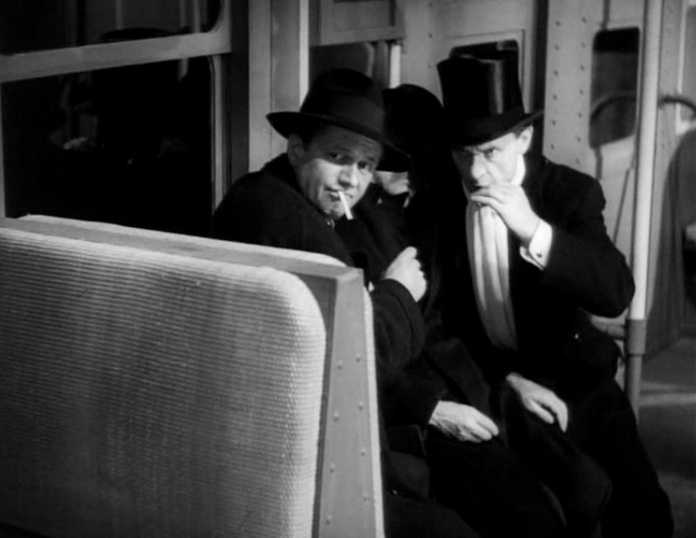
Mary loses her innocence here, and is sent running out into the night. Riding the subway back and forth in a daze, she’s startled to see two society swells propping up a third who seems passed out drunk, except that the third’s hat tumbles off and she recognises August. Mary chases down a transit cop, but the duo slip off with their charge, making it all seem like some nocturnal imagining. The mood of this scene, with the clamour of the train, sharply contrasts the pellucid silence of the factory scene, and yet compliments it, presenting another perversely claustrophobic, alienating urban environment. I can’t think of another scene like it in film before it, except perhaps in a Hitchcock film like Blackmail (1929), but it certainly anticipates in acute ways the fascination with New York’s fecund, deteriorating infrastructure in ‘70s cinema as a wonderland for evoking anxiety, and specifically a sequence like the one in which Nancy Allen dodges a killer on the subway in Dressed to Kill (1980).
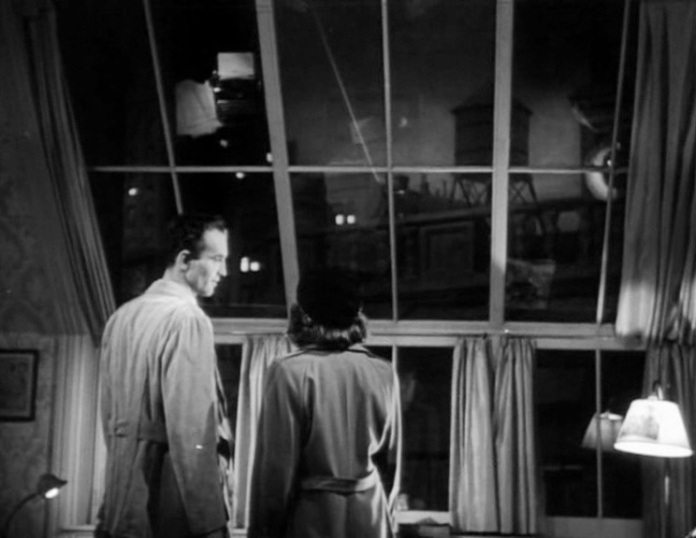
One of the Lewton series’ singular qualities was this way the filmmakers were able to turn limited resources and set-bound productions into precisely atmospheric invocations of place. Just as The Leopard Man (1943) captures the mood of a town on the fringe of the wild, The Seventh Victim follows Cat People in tangibly recreating the feeling of a big city in the hours when its streets might as well be wilderness. That canard of “eight million stories in the naked city” is suggested in Mary’s visit to Missing Persons, a simple tracking shot absorbing an array of similarly befuddled by the ease with which it’s possible to get lost in a big city, even as August tries to reassure Mary that it’s only “nine miles long and three miles wide.” The most overt poetic invocation in The Seventh Victim comes from an actual poet character, Jason Hoag (Erford Gage), in whose mind a searchlight above the Manhattan rooftops becomes “Cyrano’s sword,” cutting through “the blue cloak of a prince.” Jason invokes Cyrano de Bergerac, Byron, and is glimpsed at one point sitting “at the foot of Dante,” that is, under a mural in the Romaris’ restaurant under the boarding house, named for the poet. For the jocular Mrs Romari, all intellectual and emotionally complex propositions are humour. “Do you actually want to find your sister?” Jason asks Mary, who catches his eye when she first arrives at the Romaris. Mrs Romari laughs at him, but Jason’s sense that tracking down Jacqueline might involve soul-rending damage proves prescient. The gentle, Hart Crane-ish poet, who’s haunted by a romantic tragedy that killed his burgeoning career, begins finding his way back to functionality as he’s stirred to action on Mary’s behalf. Jason learns he’s not to be Prince Charming, but finds other things that make the effort worthwhile.

Another peculiarity of the Lewton series is the fashion in which it touches on metatextual ground without quite making it overt. Similar characters and roles recur from film to film, whilst actors appear often in interestingly, deliberately contrasting parts. For instance, here the velvet-voiced Ben Bard, who had played a stern but empathic policeman in The Leopard Man is here the leader of a Satanic coven. The Seventh Victim features the most explicit example of this tendency, as Tom Conway reiterates his role from Cat People, the psychiatrist Dr Lewis Judd. Except that he’s not quite the same Judd. For one thing, the character in the other film was mauled to death. For another, this one isn’t as coolly amoral, even if he seems at first just as superciliously obnoxious, phlegmatically brushing off a secretary’s pleas for help for her alcoholic father: “Dipsomania’s…rather sordid.” It soon proves that both Jason and Gregory have reasons to distrust the psychiatrist, who was seen with Jacqueline and Jason’s former sweetheart years before, shortly before they both vanished. Echoes of Cat People’s emotional quandaries are also apparent, the fear over loss of a loved one to mental instability and the abuse of privilege by a physician. The possibility that Cat People might indeed have been a story written by Jason as a j’accuse screed aimed at Judd, converting emotional damage into metaphorical terrors, is entirely conceivable. It’s clear enough why Lewton and regular screenwriting collaborators DeWitt Bodeen (who co-wrote this with Charles O’Neal) would bring back this character: his insolent charm, given body by Conway who was a minor marquee star, provides an engaging cynical, worldly counterpoint to the idealists and placeless drifters who populate the film, as well as a constant hint of sexual evil. Except that here the filmmakers take a chance to divert the outcome of the previous drama, as if deliberately engaging in an act of self-reflexive revision.

Judd first appears approaching Gregory as an apparent emissary from Jacqueline, shaking down the lawyer for money to support her, and remaining cagily impenetrable about what exactly is going on. He then goes to Mary, offering to bring her to Jacqueline. He takes her to an upmarket hotel, but finds that Jacqueline seems to have vanished: “She’s left me to meet them alone,” he murmurs in alarm, and flees, leaving a bewildered Mary to face “them” alone himself. The knock at the hotel room door Mary answers proves however to be Jacqueline, glimpsed only for a few seconds like a fleeting mirage. Few movie characters can ever live up to the levels of mystique as are built up about Jacqueline (notably, like Rebecca de Winter, Jacqueline is spoken of in rather awed terms, and identified by totemic monogrammed effects), and that makes the Brooks’ appearance here all the more unique. When she’s finally glimpsed, with her weird Egyptian-flapper hairstyle and haunted, moon-bright eyes, it’s only for a few seconds: Jacqueline raises a finger to her lips, warning Mary to be quiet lest she attract any of the people searching for her. She’s undoubtedly corporeal and acting for real reasons, but also, seems like some emissary of the underworld, urging silence like an enforcer of taboo and mystery. The film’s obsession with doors and staircases – leading Mary to Jacqueline, Judd wryly comments, when presented with two staircases up to the next floor, that he prefers the “left or sinister side” – as passages between worlds accords with Jean Cocteau’s use of mirrors in his intensely similar Orphée (1949).

Eventually the truth of Jacqueline’s situation begins to emerge: through Mrs Redi she became involved in a group of Satan worshippers known as the Palladists (based on a French society of Satanists rumoured to have practised in the 1800s), and because she told her therapist Judd about them, they’ve declared she must die. The Palladists are hardly however a shocking cult, but a collective that runs the gamut of bohemian oddballs, bored socialites, saturnine malcontents, homosexuals, and the physically damaged. They give a face both to the overwhelming anxiety manifesting in the darkness that crowds the edges of the film, and also suffer from it themselves, and have adopted one method of trying to feel they master life and death. Judd and Jason even move in the same social circles as the Palladists, amongst whom Redi, Mr. Brun (Bard) and one-armed hostess Natalie Cortez (Evelyn Brent) seem to be the senior members. Jason is canny enough to bring Mary and Gregory within close proximity of the coven on a hunch. Judd seems like an ideal Palladist, but he rather stands distinct from them, too intelligent to fall for their folderol, too interested by their strangeness to ignore them, and too scared of what they might do if provoked. Brun expostulates at length the peculiar dichotomy at the heart of the society’s sensibility, its insistence that anyone that breaks its oath of secrecy must die, but also its pledge to non-violence. The only legitimate way they can, then, punish Jacqueline for her transgressions is to force her to commit suicide, but failing that, a few members are willing to go further, not because Jacqueline broke their rules but because she could possibly expose and embarrass them.
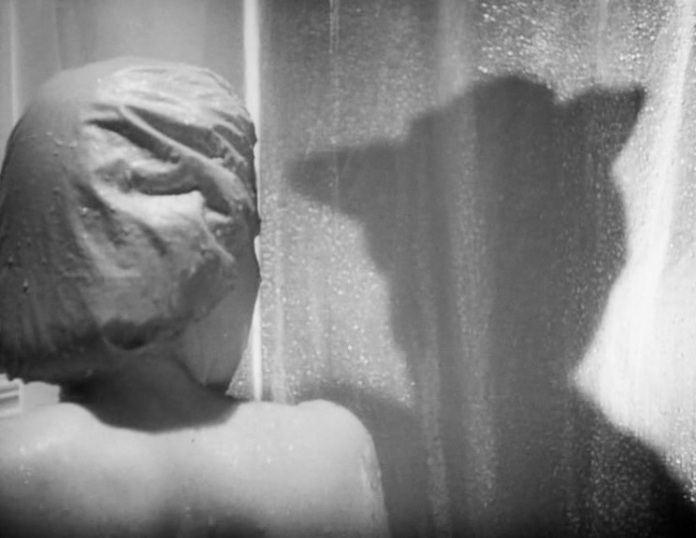
The notion that Jacqueline joined the group for erotic as well as emotional and spiritual stimulation percolates below the surface as you’d expect from a 1943 film and yet nudges me constantly, apparent in Frances’ suggestive worship and unconcealed love for Jacqueline (“The only time I was ever happy was when I was with you!”). Redi’s husky-voiced ambiguity is also telegraphed, giving a particularly piquant charge to a scene in which Redi enters Mary’s apartment to warn her off the search for Jacqueline. Mary is caught naked and dripping wet in the shower, with Redi’s silhouetted form glimpsed through the curtain. The prefiguring of Psycho here is unmistakable, although less violent, the note of erotic threat less immediate than a big knife but no less unsettling for the naïve and vulnerable girl. Redi makes a mistake, however, by doing this, because she informs Mary that Jacqueline was in fact the prisoner in the secret room, and she killed August in fright. This fact gives Jason the inspiration to finally pressure Judd, who’s been hiding Jacqueline since she escaped that night, into letting him, Mary, and Gregory take her into their care.

Jason’s tracking of Judd through a skeletal studio version of the Village offers stark, lunar-surface alleyways and blankly silhouetted, shadow-play windows, islets of warmth between oceans of dark. When Judd finally does lead the trio of searchers to Jacqueline’s door, she proves to have now lodged in some mysterious abode, descending into a deep focus frame with peculiarly numinous effect, her waiting cohort of would-be friends and protectors gathered in the foreground. Lewton’s films were usually too starkly budgeted to offer the kind of oversized Expressionistic effects found in Fritz Lang and F.W. Murnau’s early work or in Rowland V. Lee’s delirious Son of Frankenstein (1939) with their carefully contrived and constructed games with space and architecture as mimetic canvas, and besides Lewton was usually after something a touch subtler. Here Robson captures something closer to the French 1930s template of “poetic realism,” where more realistic environments were carefully manipulated to create expressive settings, here managed on the back-lot sets with an almost theatrical minimalism. Robson was following on from Tourneur’s work, and pointing the way forward to the similar mix the most visually vivid noir films would sport within a few years. Many of the personnel who worked with Lewton, including Robson, had indeed worked on Orson Welles’ costly but deeply influential works at the studio, and indeed in many ways Lewton and team found practical applications for much that Welles had helped evolve.

Jacqueline’s “return to life” however proves disorientating: taken to Jason’s studio, she recounts August’s killing in a spellbinding moment, with Robson tracking his camera in slowly to her wan and haunted face, and then finally her eyes, a shot that summarises, for me, the essence of Lewton’s achievement and perhaps indeed the genre. Where before she had ministered silence to hold the abyss at bay, now she confesses with words but those eyes say more about abysses she’s seen into. As tawdry as the Palladists are, the terrors they’ve evoked for Jacqueline after a life of frantically seeking sensual experience have pushed her to the edge of sanity, of liminal awareness, which with her morbidly fixated nature she feels experiences with all the acuity of a Dostoevsky character. At the same time, Jason, realising his romantic hopes are fading as Mary is gravitating more to Gregory’s paternal charm, tries to hint, by way of his extended Cyrano metaphor, to Jacqueline that her husband is in love with her sister. A dance of attraction has been in motion behind the scenes, between the carefully calibrated types: Gregory as upholder of order, Jason as protean creator, Judd as guardian of the psyche and healer, with Mary and Jacqueline, objects of their affections, as mirroring siblings, who embody Songs of Innocence and Songs of Experience, in William Blake’s parlance.
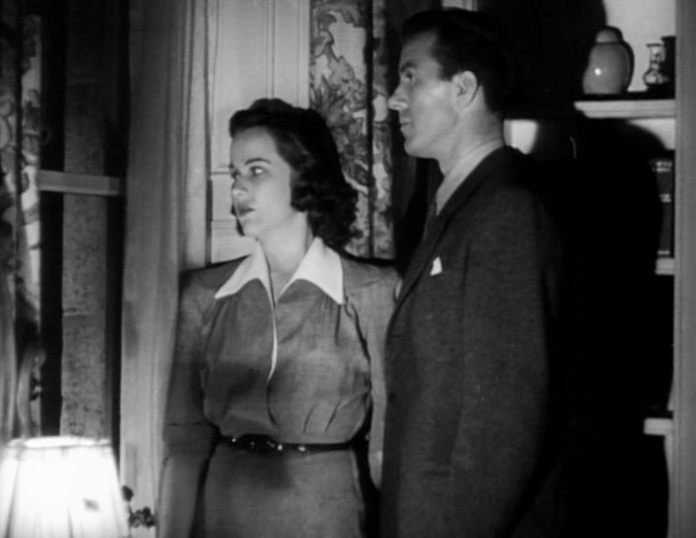
The dance ends unsatisfyingly on one level: it’s hard to believe Mary would fall for Gregory, if only because, like too many of Lewton’s heroes, he’s played by one of RKO’s usual, deathly dull leading men, in this cause Beaumont, who would later find his role comfortably numbing us all as the patriarch of Leave it to Beaver. It does make sense on a psychological level, as Gregory has presented to both Gibson girls the ideal of the settled, paternal male, and through him an illusion of familial solidity. Jason, denied the girl, is rewarded with renewed creativity and also in discovering his accord with Judd, who proves to actually have been a benefactor, protecting Jacqueline and Jason from harm by life’s crueller facts. When he explains that Jason’s long-ago sweetheart, the one he saw Judd with, is now irretrievably insane, “a horrible, raving thing,” he recognises that Judd has been his friend all along. Judd’s own admissions to jealousy of Jason’s accomplishment with his first book gives way to his scepticism over his new work: “the time is out of tune,” he says, for such a romantic artist in a bleaker time. This touch reflects the peculiar status of Lewton’s films, their blend of darkness and light, homey emotionalism so nimble but frail in contrast to overwhelming evil, which marked the producer’s sensibility out of place in ruder environment of Hollywood, and yet came closer than almost anyone else to recording the psychological undertone of his era: The Seventh Victim, after all, was made in the midst of World War 2, and if any epoch could shake a person’s faith in common humanity and yet also offer many proofs for it, that was the one.

As Tourneur and Wise went on to make some definitive films noir, Robson’s different touch would become clearer as he would make some excellent works situated rather at the nexus of noir with urban drama and social realism, like Champion (1949) and The Harder They Fall (1956), whilst fervently emotional melodramas amongst like Peyton Place (1957), From the Terrace (1960), and Valley of the Dolls (1967), coherently extend the female-centric sensibility he could adopt, apparent here and in his follow-ups for Lewton, Isle of the Dead and Bedlam (1946). Like Wise, Robson essentially became an all-round artisan who could be relied upon by the studios even as they floundered: it’s hard to imagine a film more diametrically opposed to the delicate horrors of this film than Earthquake (1974), Robson’s second-last work. The melancholy effect of The Seventh Victim is strong and genuine, especially considering that Lewton had used it to express his own mortal anxiety: he would die aged 46, whilst Gage would be killed in combat in the Philippines a year after the film was shot, and Brooks would die young from alcoholism.

It’s remarkable, considering how dense and suggestive the narrative of The Seventh Victim is, that the film only runs a fraction over 70 minutes. The sense of compression is leavened slightly by the artificial effect of Mary and Gregory’s romance, although their couple’s last scene together, as Gregory asks Mary not to look at him as he both declares his ardour but also states his intent to deny it for Jacqueline’s sake, is delicately lovely and only needs a more convincing context. Judd and Jason’s rebuke to the Palladists awkwardly approaches a note of standard-issue piety Lewton usually artfully avoided. But this is both more complicated and simpler than it seems as it bears out a consistent aspect of the Lewton series, a belief that sometimes the most complex things are summarised best by the simplest words, especially matters like human interdependence. Judd offers the Lord’s Prayer – “Forgive us our trespasses” – with a direction to actually consider what it implies in retorting to Brun’s respect for “Satanic majesty and power” by implying his belief is far cornier, with the implication that, to quote another Donne poem, no man is an island, and that the Palladists, rather than finding exclusive power, have instead left themselves tragically cut off from the only things that make life bearable.

Apart from these stumbles, the last fifteen minutes are remarkable, as Jacqueline, brought out from the shadows by her friends, proves to have only been made vulnerable to her enemies. Kidnapped from Mary’s rooms, she’s kept by the Palladists in Cortez’s place, browbeaten by the gathering into drinking a cup of poison, with Robson’s framings teeming with Dutch Master-like faces looming out of chiaroscuro lighting, and Brooks with her nemesis, the glass, looming before her, voices of encouragement, alternately bullying, seductive, and despairing, whilst Jacqueline resists with cool boredom: “No, no, no…” When she finally does raise the chalice to her lips, Frances knocks it from her hands, an act of mercy from a friend moments after Frances was hysterically imploring her to drink. Jacqueline is released, but one of Palladist goons who had helped spirit August away now stalks her through the dark streets in perhaps the most epic of the many sequences of anxious midnight wandering in the Lewton series. Like Mary in the subway scene, Jacqueline finds herself utterly alone in the midst of the great city. She can’t appeal to the oblivious passers-by to protect her from the almost abstract threat that pursues her, the stalker’s face gleaming deathly pale as he looms out of shadows, building to a climax when Jacqueline edges her way along a wall in trying to escape a blind alley, only to feel the coat of her pursuer, lying in wait for her. A hand grasps her wrist; a knife flicks open.

Jacqueline is only saved by the sudden eruption of a coterie of actors from their theatre’s rear entrance: one of the male actors grabs Jacqueline up, offering to buy her a beer and a sandwich, and spirits her to safety. These folk are more than actors; they’re like an explosion of the life essence itself, emerging from doors with the Comedy and Tragedy masks painted on. The irreducible linkage of the two faces lies at the heart of The Seventh Victim’s obsession with mortality. Jacqueline cannot follow the actors into the tavern to share their Bacchanalian love of life, wandering away instead back to the Romaris’ boarding house, where she encounters one of the other residents, who throughout the film has only been glimpsed shuffling from one door to another. This is Mimi, a withering, consumptive woman waiting to die, played by another Lewton regular, Elizabeth Russell.
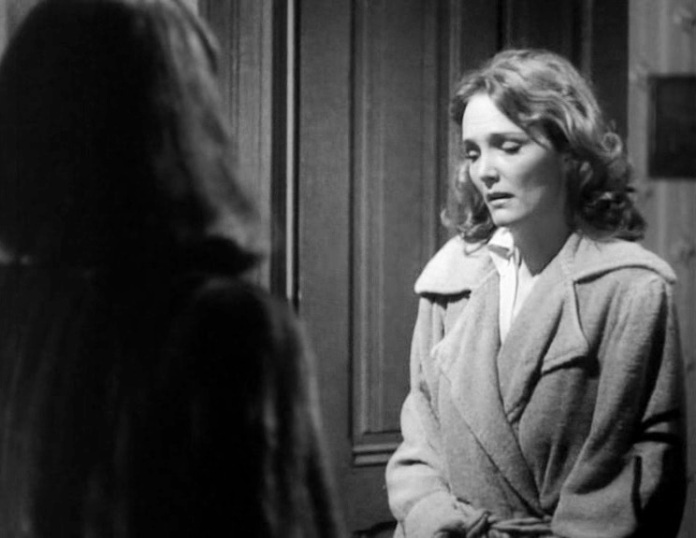
Just as Russell played the sinister foreign woman who mysteriously recognised her “sister” in Cat People, here she recognises Jacqueline as fellow lost soul, and states her intention to go out and have fun rather than wait for death, in a monologue that’s both chilling and pathetic: “I’ve been so quiet, oh so quiet, I hardly move, yet it keeps coming for me all the time.” The firelight from within her room casts infernal flickering on the scene. Jacqueline’s final realisation that Mimi will die anyway precipitates the seemingly off-hand, yet bone-chilling final moment. Mimi, dressed up, leaves her flat and moves down the stairs, only distracted for a moment by the odd sound of a toppling chair in Jacqueline’s room, the confirmation that Jacqueline has finally taken her last option. A throwaway touch here underlines the overtone of inevitable fate being met: where the Palladists had mentioned that so far six deaths had been listed for the six betrayals their organisation had recorded, so Jacqueline’s apartment is numbered 7. The final effect is tragic, and yet as a whole, like all of Lewton’s films, The Seventh Victim is peculiarly life-affirming: enjoy it while you have it.

I love the little details – you mention the girls reciting in Latin and French. The Latin is conjugations of the word for “love”, the French is “search”.
LikeLike
“One reason for this slow yet indelible effect of The Seventh Victim was that it followed Cat People in proving a horror film could be set in a completely contemporary urban landscape, transformed into a world of dreamlike vignettes and private netherworlds, and unlike its precursor was able to do so without any hint of the supernatural, presenting a situation where human folly creates horror.”
Indeed Rod. Lewton’s strongest abilities are, as Agee rightly opined, poetic and cinematic, rather than literary or romantic. Taking it further one can safely declare that there are two Lewton masterworks: “I Walked With a Zombie” (the more elegant and eloquent visually) and “The Seventh Victim” (the more poetic and profound) and for both Lewton (yes Tourneur and Robson were the directors too! Ha!) devised a fragmented, mosaic-like structure that set aside the manner of telling a story in favor of sketching in its borders and possibilities. Much like Bresson’s technique in “Au Hasard Balthazar” he favors letting the audience fill in the gaps. The prevalent theme in all of Lewton’s films -the conflict of the powers of reason dueling against the powers of the unknown.
I had once read somewhere that Lewton family members after a viewing of “The Seventh Victim” after his passing, claimed they “felt him in the room.” The film is certainly his most personal production and in a sense his most radical. As his first film without Tourneur, it explains the personal experience that is imparted in the screenplay. In any event there is a certain existential underpinning (you incorporate this well into your mammoth essay here) and a nihilistic contest in the work. Brooks is unforgettable. Again great job with one of the greatest American films of the 40’s and a Lewton masterwork.
LikeLike
Bev, yes, there’s so many of those moments. I recall reading that a lot of those sorts of touches were inserted into the script by Lewton as Hitchcock used to do. The fact that Jacqueline’s noose room is numbered 7 is another pertinent example, so throwaway you don’t notice until the seventh viewing, and which reminds me of how Hitchcock revised the room number of Eva Marie Saint in North by Northwest to add up to 13 for death. Another good example is the way the La Sagesse logo, which Mary doesn’t know yet is the Palladist symbol, is silhouetted on her back as she sends August up the hall; the shadow of evil is upon her at that moment.
Sam: great comments there on the peculiar structuring and the similarity with Bresson (indeed, Pickpocket and The Trial of Joan of Arc also have a rather Lewton-esque feel. Powell and Pressburger also often edged into his territory and approach; the imprint of Isle of the Dead on Black Narcissus is strong, and this film feels spiritually close to The Red Shoes and The Small Back Room). As for Lewton’s imprint on the film, indeed, one of the reasons his works are so indelible lies beyond their quirkiness and their approach to genre, but in that rare (for Hollywood films of the time) sensation of a lack of distance between audience and creator, the distinctness and definition of the personality(ies) at work.
LikeLike
” … nine miles long and four and a half miles wide.” ( The Devil is in the Details)
LikeLike
I am now in my 83rd year and your aperçu of Seventh Victim throws me back to a two feature plus filmic oddments offered for the princely sum of seven cents at the 86th Street Grande. As a 11 year old, I got it! Familiarity with Raskolnikoff and other Slavic oddments purveyed by the Hollywood/Nazimova/Lewton critters was an adequate VADE MECUM. Subliminal insights, of course, as always.are time telescoped.
LikeLike
Me again! The “cult” trademark “La Sagesse” is simply French for unfolding Wisdom. Poe’s “The Purloined Letter” comes to mind.
P.S. Perhaps Widom as”Cosmetic” is another path worth pursuing.
LikeLike